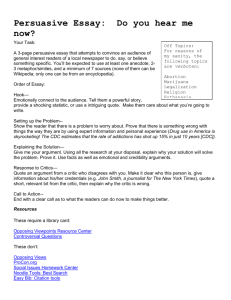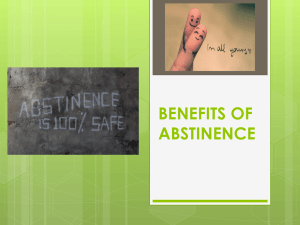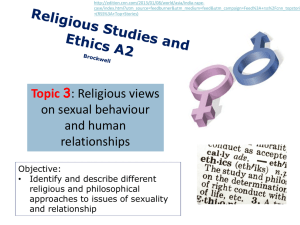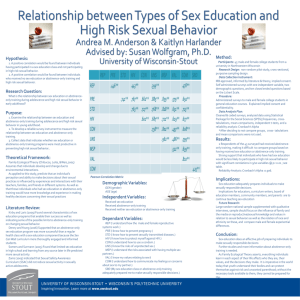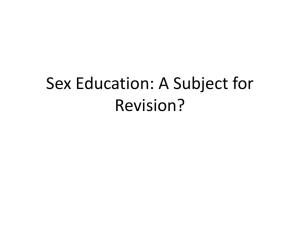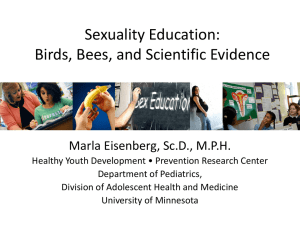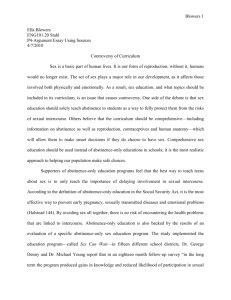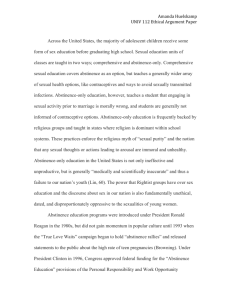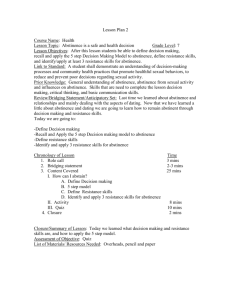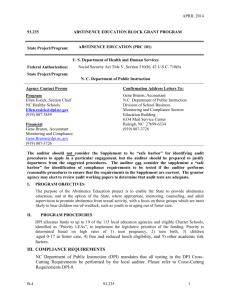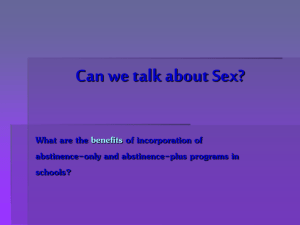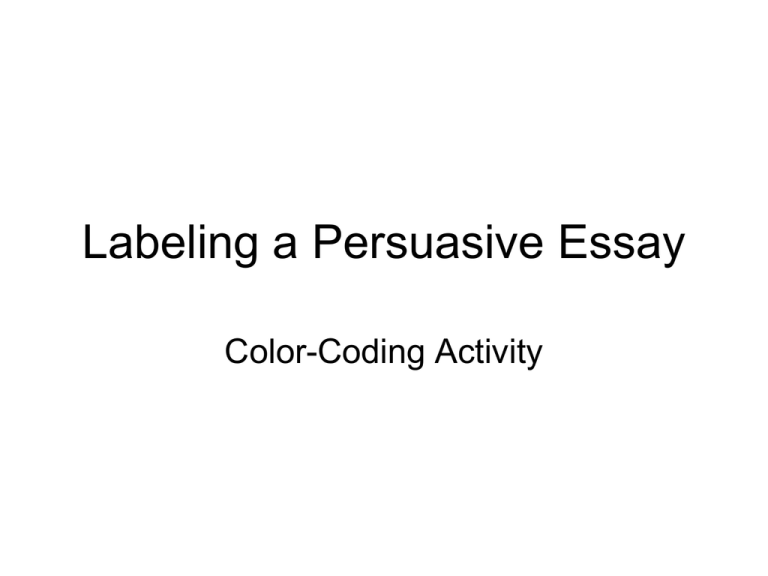
Labeling a Persuasive Essay
Color-Coding Activity
Introduction
Hook
Transition to
background
Background
information
Transition to
thesis
Thesis
Sex education is important, but many students finish sex
education classes with a distorted view of sexuality and without a
good understanding of contraception and safe-sex practices.
Instead, children only learn that they should not have sex until
they are married.
Sex education, first introduced in public schools as social
hygiene education in the early 1900s, expanded in scope over
several decades in an effort to reduce the rate of venereal
diseases (Brown). Controversy over contraception options began
in 1960 with the advent of the birth control pill (Goraliski).
Curriculum in the 1970s aimed to reduce teenage pregnancy
rates while awareness of AIDS and other sexually transmitted
diseases (STDs) shifted the focus to safe sex in the 1980s
(Brown). The Adolescent Family Life Act in 1981 introduced
abstinence-only programs that gained momentum in the late
1990s (Brown).
These programs have the good intention of persuading young
people to wait until marriage before having sex, but abstinenceonly programs are not achieving this goal and are flawed by the
distorted and biased perspective that they promote.
All schools should educate students not only about abstinence,
but also about safe sex practices and pregnancy prevention
methods.
Body Paragraph
Topic sentence
Concession
Paraphrase the
concession
Concession
Rebuttal
Set up
evidence
Evidence #1
So What?
Studies show that abstinence-only programs do not reduce sexual activity
by young people.
Some parents or others may object that teaching sex education to students
encourages youth to engage in sexual activities.
Those in opposition believe that sex before marriage is wrong and
abstinence is the only safe sex (ProQuest Staff).
However, the research overwhelmingly suggests that simply teaching
students how to abstain from sex will not prevent students from engaging in
sex before marriage.
In 2007, the United States Department of Health and Human Services
released a study of abstinence programs.
This government-funded study involved more than 2000 students. The
authors discovered that findings from this study provide no evidence that
abstinence programs implemented in upper elementary and middle schools
are effective in reducing the rate of teen sexual activity (“Impacts”). The
authors concluded that findings indicate that youth in the abstinence-only
programs were no more likely than students not in the programs to have
abstained from sex (“Impacts”). In addition, among those who reported
having had sex, they had similar numbers of sexual partners and had
initiated sex at the same mean age (“Impacts”).
Apparently, students did not benefit from all of the effort and the millions of
dollars that have gone into these programs. These ineffective programs are
leaving students without the knowledge they need when they make certain
choices; this type of education is failing today’s teenagers. Therefore,
schools need to provide comprehensive sexual education classes.
Transition, set
up evidence #2
Evidence #2
So What?
Transition, set
up evidence #3
Evidence #3
So What?
Clincher
Another study by Peter Bearman of Columbia University shows that 88
percent of middle and high schoolers who pledge to stay virgins until
marriage end up having premarital sex anyway (Kelly).
He adds that “the bad news is that they are less likely to use
contraception the first time they have intercourse” (Kelly).
Although students may have good intentions in signing virginity contracts
while enrolled in an abstinence program, the reality is that teaching
abstinence does not prevent those students from engaging in sexual
activities. While contracts like these may help students make good plans,
the students also need education to help them know what to do if their
plans change.
Additionally, Dr. S. Paige Hertweck, a doctor who contributed to an
American Academy of Pediatrics report on teen sexual activity,
states that “teaching abstinence but not birth control makes it more likely
that once teenagers initiate sexual activity they will have unsafe sex and
contract sexually transmitted diseases” (“Doctors Slam Abstinence”).
In abstinence-only programs, students are taught to “just say no” to sex.
They are not taught the information that they need to know about safe sex
and contraception if they later choose to say “yes,” as many of them are
doing. Schools need to close this gap and provide students with all the
knowledge they will need in their adult lives.
Since abstinence-only programs have proven ineffective in reducing the
number of young people engaging in sex, schools must provide sex
education to protect students from diseases and pregnancy.
Conclusion
Restate Thesis
Summarize
body
paragraphs
Final clincher
Schools need to educate students on both abstinence and
safe sex practices.
Sexual activity by young people is an important concern. In
an ideal world, maybe everyone would wait until marriage
before having sex and would then remain in a single,
monogamous relationship. But this is not the reality. It might
be a good goal to try to convince young people to wait until
marriage before having sex, but taking this approach alone to
sex education is not working. After ten years and a half of a
billion dollars in federal funding, abstinence-only programs
have not had a positive impact on the sexual behavior of
teenagers. The programs may even cause harm because of
the distorted and biased views that they promote and
because of the information about safe sex and contraception
that they do not teach.
It is time to put an end to abstinence-only programs and to
give students more comprehensive sex-education programs
that better prepare them for the future.

